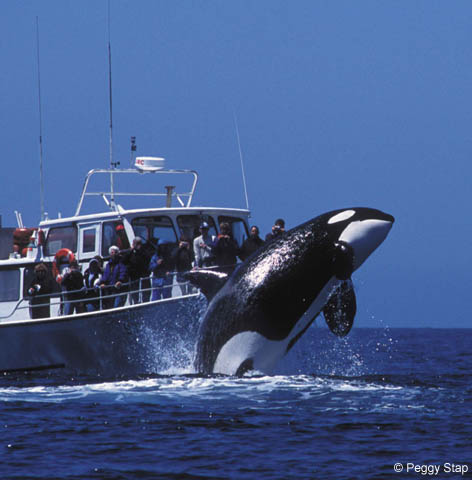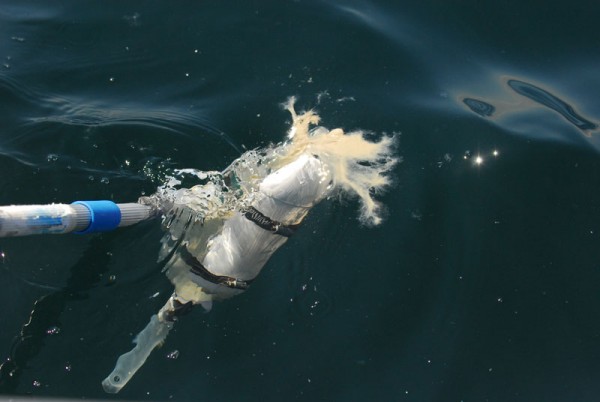The Stress Response of Killer Whales (Orcinus orca) to Whale-watching Boats

One explanation for a whale breaching is that it is a sign of aggression or a demonstration of strength (http://www.sinclair2.karoo.net/Whalewatchers/cetacean_behaviour.html).
Photo Credit: http://www.montereybaywhalewatch.com/images/Features/0412/KillerWhaleBreachingPS.jpg
Introduction: Southern Resident Killer Whales
The local population of killer whales, known as Southern Residents (SRKW), is listed as endangered and many studies have been done to determine why the population is in decline. This population of killer whales (Orcinus orca) in the Puget Sound and British Columbia area has declined from a high of 98 in early 1995 to a low of 78 in 2001 (2). Although usually studies of human effects on marine mammals focus on lethal outcomes, some recent research has been done on non-lethal anthropogenic effects on marine mammals, and specifically cetaceans (11). In the Puget Sound, it is speculated that the SRKW population is in danger due to decreased prey availability (due to the endangered or threatened status of many salmon species) and to the level of toxins in the water that accumulate in the blubber of marine mammals. However, other direct, but non-lethal human disturbances may also be attributing to the decline of the SRKW population.
The Stressor: Proximity of boats and Vessel noise
One human impact that has increased steadily over the last several years is whale-watching. The decline in the SRKW population is strongly correlated with the increase in whale-watching fleet size (3). It likely is stressful to be followed or chased by humans and boats, but this cannot be proven as well as the effect that vessel noise has on the cetaceans. Romano et al. investigated the effects of intense underwater sound on nervous system activation and immune function in the white whale and the bottlenose dolphin (7). By many research groups, vessel noise is acknowledged as a stressor on cetacean species, such as the SRKW (3, 5, 7, 9, 11, 12). Noise travels further in water than it does in the air. Noise also travels further than light does in the water. It is for these reasons that marine mammals developed communication and foraging tactics that utilize sound instead of sight and why noise exposure is a stressor on marine mammals (12).
Cellular, Molecular, Endocrine Response
There has not been much specific study on the stress response of killer whales or marine mammals at all, but many researchers agree that the mammalian stress response is highly conserved and can be accurately extrapolated to marine mammals (8, 11, 12). Two endocrine systems act in the vertebrate stress response: rapid effect through catecholamines, and prolonged effect through glucocorticoids (8).
In the catecholamine response, epinephrine and norepinephrine are released from the adrenal medulla. This “fight or flight response” is very rapid and leads to increased heart rate, decreased digestion, increased brain blood flow, increased visual acuity, increased gas exchange efficiency, and increased glucose metabolism (8). In the study by Romano et al, increasing sound levels corresponded to a response of increased epinephrine, norepinephrine, and dopamine levels. These hormones were also significantly higher after high-level sound exposures compared with low-level sound exposures (7).
The glucocorticoid pathway incorporates steroid hormones, specifically cortisol for marine mammals, which lead to gene transcription and protein production (8). This response is initiated when the sympathetic nervous system, primarily the amygdala and hippocampus, perceives the stress or interprets the internal/external stimulus (8, 11). A signal is then sent to the hypothalamus which releases corticotrophin-releasing factor (CRF) that in turn binds to receptors on the anterior pituitary gland. This stimulates the release of adrenocorticotropic hormone (ACTH) that stimulates the production of cortisol at the adrenal cortex (8). Cortisol binds to intracellular receptors which enter the nucleus and initiate transcription. The broad effects of transcription initiation include (on a prolonged time scale); increased blood glucose, altered behavior, inhibition of growth and reproduction, and immunosuppression (inhibition of cytokines, antigens, B cells, T cells, etc; 8). The goal for physiological stress response is to survive the current threat, not necessarily to preserve function for the future (11).
There has been preliminary evidence that numbers of private vessels around killer whales adds to the whale's "stress" levels. In particular, whale-watching fleet size correlates with higher cortisol levels in the SRKW (1). Fecal samples from local SRKW populations have been taken throughout the summer for several years and the level of cortisol hormone has been measured through radioimmunoassays (1). At certain times of the year, such as the summer holidays, Memorial Day and Labor Day, increased whale-watching fleet size has corresponded to increased cortisol levels. The same method was used to successfully measure cortisol levels in another marine mammal species, Steller sea lions (Eumetopias jubatus; 6).

Fecal sample acquisition trip by the Center for Conservation Biology. The "conservation canine" named Tucker looks for killer whale scat.
Photo credit: © Fred Fellman http://conservationbiology.net/research-programs/killer-whales/

Killer whale poop scoop.
Photo credit: http://conservationbiology.net/research-programs/killer-whales/
Behavioral Response
In response to whale-watching, whales may leave the area or show some other type of avoidance (11). Avoiding vessels may be energetically expensive and require an animal to eat more but also maintain vigilance against vessels that reduces the amount of food able to be consumed (9). In the presence of boats, whales reduce the amount of time spent feeding (10). Williams et. al estimated that this corresponds to a decrease of 18% in energy intake (10). Short-term stress was also found to lead to long-term abandonment of a habitat (5).
The behavioral response to vessel noise has been studied in depth for many cetacean species, specifically local SRKW populations. In Seattle, a recording system was used to find that SRKW’s increase their call amplitude by 1 dB for every 1 dB increase in ambient noise; and nearby vessel counts positively correlated with ambient noise levels (4). Vessel noise masks noise made by whales to communicate and forage. A small increase in auditory detection threshold leads to a dramatic reduction in prey detection capability (3). Therefore, the range of prey detection decreases as ambient noise increases and prey must be closer for whales to detect it by echolocation in times of increased ambient noise (3). The model by Bain et. al estimates that the noise level in the San Juans has led to a 95% decrease in prey availability (3).

Killer whales use echolocation and rely on auditory information to capture prey.
Photo credit: http://www.whaleresearch.com/old/images/echolocation.jpg
Impact and Implications
The reduction in the energy balance by energy demand increase and energy acquisition decrease through vessel avoidance has many implications on the individual and population levels. Growth may be suppressed, which may lead to a delay in reproductive maturity and decreased pregnancy rates (9). Reducing the range of signals for foraging and communication due to ambient noise in particular also leads to a decrease in the energy balance of killer whale individuals (12). If individuals abandon or avoid a particular habitat due to human disturbances, the new habitat may not have all the desired characteristics besides being free of anthropogenic influence (5). All these effects lead to decreased fitness of individual whales.
The stress response also has a negative impact on killer whale populations. Reproductive and immune response suppression that is initiated by the stress response leads to decreased fecundity and survivability in the individuals, and also at the population level (11). Decreasing fitness, survivorship, and fecundity of this marine mammal species is critical due to its endangered status. Any human impact that can be stopped so that the stress levels in the local, endangered SRKW decreases would benefit the population on its way to recovery.
References
1. Ayres, KL. PhD candidate, Center for Conservation Biology, UW Department of Biology. Personal communication. November 20, 2009.
2. Bain, D. and Balcomb, KC. 1999. Population trends of southern resident killer whales (Orcinus orca) from 1960-1999. Report submitted to November, 1999 SRG Meeting, Maui, HA.
3. Bain, DE, Trites, AW, and Williams, R. 2002. A model linking energetic effects of whale watching to killer whale (Orcinus orca) population dynamics. Friday Harbor Labs Report, University of Washington.
4. Holt, MM, Noren, DP, Veirs, V, Emmons, CK, Veirs, S. 2009. Speaking up: killer whales (Orcinus orca) increase their call amplitude in response to vessel noise. Journal of the Acoustical Society of America, 125(1): 1-6.
5. Lusseau, D. and Bejder, L. 2007. The long-term consequences of short-term responses to disturbance experiences from whalewatching impact assessment. International Journal of Comparative Psychology, 20: 228-236.
6. Mashburn, KL. and Atkinson, S. 2007. Seasonal and predator influences on adrenal function in adult Steller sea lions: Gender matters. General and Comparative Endocrinology, 150: 246-252.
7. Romano, TA, Keogh, MJ, Kelly, C, Feng, P, Berk, L, Schlundt, CE, Carder, DA and Finneran, JJ. 2004. Anthropogenic sound and marine mammal health: measures of the nervous and immune systems before and after intense sound exposure. Canadian Journal of Fisheries and Aquatic Sciences, 61(7): 1124-1134.
8. Romero, LM, and Butler, LK. 2007. Endocrinology of Stress. International Journal of Comparative Physiology, 20(2): 89-95.
9. Trites, AW, Bain, DE. 2000. Short- and long-term effects of whale watching on killer whales (Orcinus orca) in British Columbia. Paper presented to the IWC Workshop on the Long-Term Effects of Whale Watching. Adelaide, Australia.
10. Williams, R, Lusseau D, Hammond, PS. 2006. Estimating relative energetic costs of human disturbance to killer whales (Orcinus orca). Biological Conservation, 133: 301-311.
11. Wright, AJ, Deak, T, and Parsons, ECM. 2008. Concerns related to chronic stress in marine mammals. SC/61/E16: 1-7.
12. Wright, AJ, Soto, NA, Baldwin, AL, Bateson, M, Beale, CM, Clark, C. et al. 2007. Do marine mammals experience stress related to anthropogenic noise? International Journal of Comparative Physiology, 20: 274-316.
This page was developed as part of the course at the University of Washington: Integrative Environmental Physiology